#427 cubic inch V-8
Photo
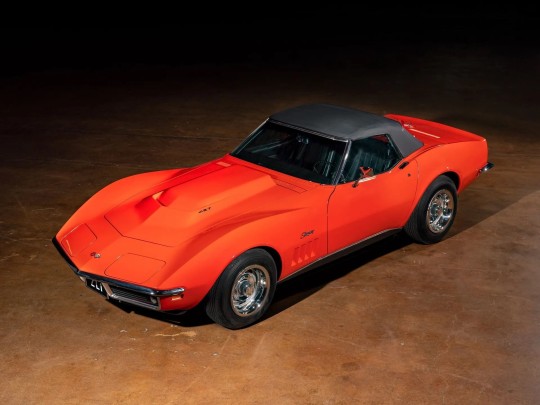

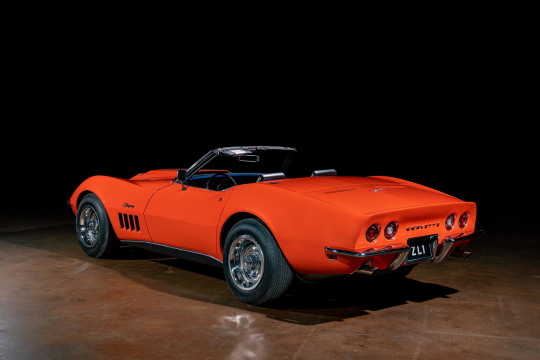
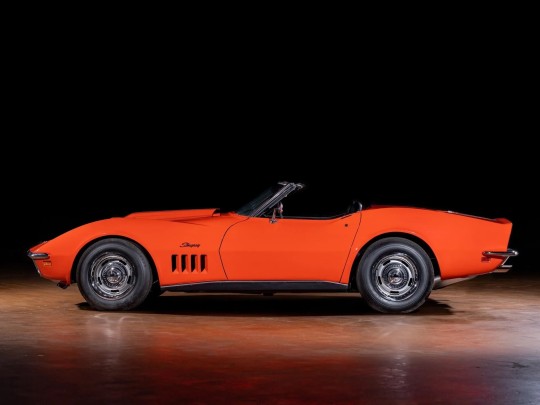
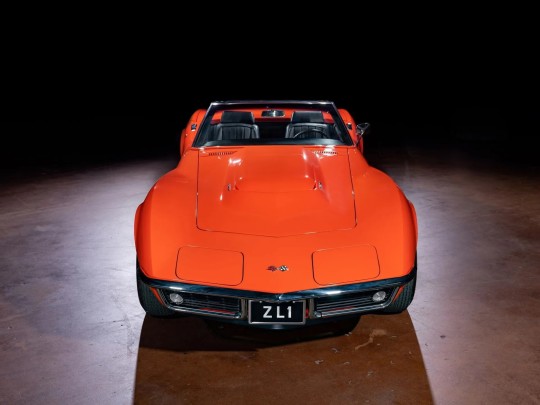

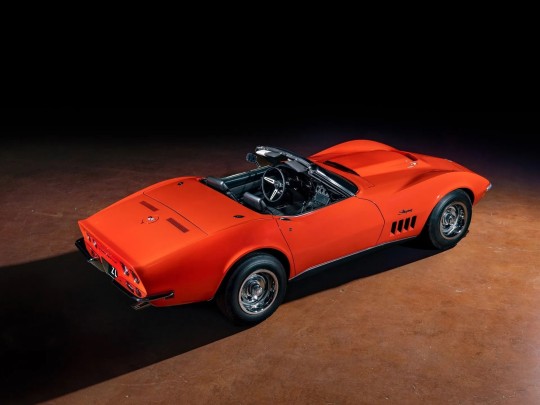
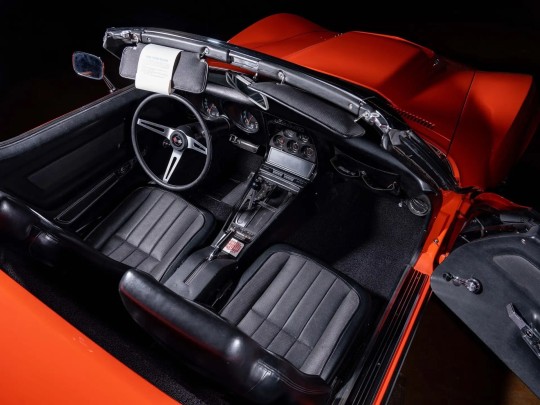
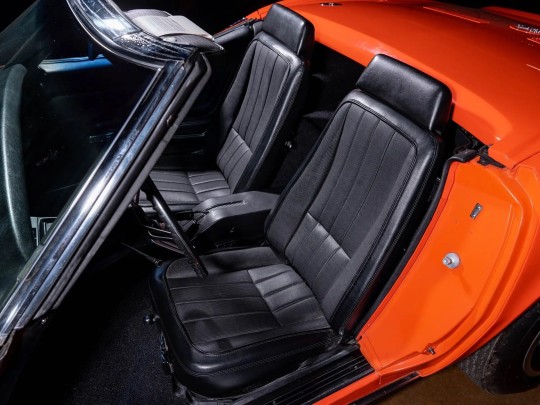

1969 Corvette Stingray ZL-1 Convertible
this particular example was “strictly developed as an FIA/NHRA homologation experiment” and is the first of two factory-documented Corvettes with the high-performance RPO ZL-1 option—an aluminum version of Chevrolet’s monstrous 427-cubic-inch L88 V-8 engine. (The second model was a coupe.)
The bright-orange convertible was then sold to drag racer John W. Maher of Leechburg, Pennsylvania, in December 1968, coupled with an M40 automatic transmission. At the time, the $4,718 package more than doubled the base price of a new Corvette.
The vehicle remained in the driver’s possession until 2007 when it was sold to Kevin Mackay’s Corvette Repair Inc., which then had the convertible fully restored in 2014 and installed an early, factory-correct, date-coded, all-aluminum ZL-1 unit.
Courtesy: RM Sotheby’s
#art#design#spotycars#sportcar#vintagecars#vinatgecar#corvette#orange#1969#corvette stingray ZL-1#convertible#luxurycars#luxurycar#luxurylifestyle#rm sotheby's#ZL-1
197 notes
·
View notes
Text
1969 Chevrolet Corvette Coupe L88
The L88 was a special option package developed under the direction of Zora Arkus-Duntov, director of GM’s performance division. First introduced in 1967, the L88 Corvette featured a highly modified version of Chevy’s 427-cubic-inch V-8 engine. Although this engine received a factory horsepower rating of 435, actual engine output was somewhere between 540 and 580 horsepower, giving the “stock”…

View On WordPress
0 notes
Text
Savage New Canaan The Fatality Of The Muscle Mass Auto
Exactly how could muscular tissue vehicles, one of the most effective inexpensive autos the globe had seen, shed their oomph so quickly? What caused them to go away? I'm not a private detective, not from another location like one, however this was one case I had to solve.
It took place back in the 70's, but the proof was still there. It held true of the going away horsepower as well as this is what occurred.
In the age of the muscular tissue cars and truck power was whatever. It didn't matter what it was, cars, household vehicle, pick-up; it had the greatest V-8 feasible packed under the hood. Cubic inches were king and also advertised power was expensive. These vehicles could kick sand in the windshields of anything else on the road.
Yet after that horsepower appeared to vanish overnight!
Take my preferred muscular tissue car, the Ford Mustang. The aggressive designs had V-8s, though meeker models came with an inline six. The greatest 6 had 200 cubic inches and 155 hp in 1969/70.
Michael Savage 1800Accountant
What did the V-8s punch out? One of the most powerful 351 provided 300 hp in 1970 and also the 427 gave a massive 390 hp in 1968. Yet by 1973 the most effective Mustang had a 351 V-8 with just 156 hp. Nearly half what it had in 1970, and just one horsepower greater than the 200 cu in 6 of 1970! When it comes to the Mustang II of 1974, we won't also go there.
The tale was similar with the other suppliers. What was taking place? It simply didn't build up. Could I trust the figures?
My investigator advisor, Agatha Christie, educated me that when you're resolving an instance you can't rely on anyone. Murderers do lie. In this case it wasn't murder though it was the death of the muscle mass auto, and it wasn't a lot of an outright lie as not telling the entire reality. As well as outside pressures went to play.
I had to dig deeper. I needed to locate the truths. Why would horse power practically cut in half?
It ended up there were a couple of reasons. Salesmanship was one. Horsepower was everything so why not determine it in a sales person pleasant way? Gross SAE horse power was utilized. Power was gauged at the flywheel without any power-hungry devices attached. Just the bare basics were utilized.
In 1972 SAE Web dimensions were phased in. Power was still determined at the flywheel however all the accessories were set up including the complete exhaust system, discharge controls, all pumps and the alternator. SAE Internet can't be compared specifically to SAE Gross since there are just a lot of variations in determining, but it is down about 80%. So power ratings dropped. In 1973 horse power rankings decreased again as power sapping discharge controls were tightened up.
Gross SAE horse power had pressed the listed power up. So did the marketed horse power some car business used. What's wrong with a little rounding up of the numbers for the pamphlet? Surely that would certainly help sales also.
All this horsepower galloping around got seen and also not simply by young individuals.
Security legislators saw, therefore did insurance companies that began billing a lot more for insurance coverage. Words on the road is that in 1967 a young man under 25 with a clean driving record would have paid $700 a year for GTO coverage. Ouch! Some vehicle firms lowered their advertised horsepower rankings.
Muscular tissues peaked in 1970, as well as by 1971 they were starting to get flabbier. Engines were being detuned and within another year bigger engines were being gone down.
Michael Savage 1800Accountant
In 1973 several muscular tissue vehicles were a shadow of their previous selves. And also they were rounded off by the oil situation of late '73. Lengthy lines at gas stations and skyrocketing costs were a genuine shock, and so was a 55 mph national rate restriction. Car were reckless, pricey as well as unwanted, it didn't matter how much fun they were.
So there you have it. I currently recognized what had happened to all that brute power. Some overestimation had actually pushed detailed horse power up. A fairer, more precise determining system brought it down. Emission controls brought it down much more, and also soaring insurance policy prices made ground-thumping power also expensive to have. The oil situation finished the muscle mass vehicle off. This situation was fixed.
0 notes
Text
The Chevrolet Corvette's Complete History, From C1 to C8


1953: Humble BeginningsChevrolet rushes the Corvette into production following the model's debut at GM's 1953 Motorama show. The two-seat roadster uses fiberglass body panels and relies on Chevy's tried-and-true Blue Flame inline-six for motivation. While the six-cylinder powerplant produces 115 horses in Chevy's sedan, the bow-tie brand tunes the engine to make 150 ponies in the Corvette. A two-speed automatic is the only transmission offered, and all of the cars are painted Polo White and wear a red interior. Chevrolet produces 300 Corvettes in 1953 and sells just 183 of them. Assign blame to the vehicle being neither civilized enough to be a true grand tourer nor engaging enough to appeal to the sports-car crowd.Car and Driver

1954–1955: Find Me in Saint LouisThe first few Corvettes are produced on a small assembly line in Flint, Michigan. However, by the end of 1953, Chevrolet moves production of its sports car to Saint Louis, Missouri. The 1954 Corvette adds three new paint colors (black, red, and blue) and trades the previous black top for a tan one. A revised camshaft adds five horses to the six-cylinder engine's stable. Despite these improvements, Chevrolet still struggles to sell the Corvette. While the Saint Louis factory is capable of producing 10,000 Corvettes per year, it yields just 3640 units for 1954.
Car and Driver

1954–1955: Find Me in Saint LouisNew life comes to the Corvette in 1955, when Chevrolet finally shoves its 4.3-liter (265-cubic-inch) V-8 under the model's hood in a fit of good sense. The 195-hp engine brings with it an available three-speed manual transmission. For the first time, the Corvette offers drivers proper sports-car performance.Car and Driver

1956–1957: Birth of a LegendChevrolet fully transforms the Corvette for the 1956 model year. A revised front end is reminiscent of the Mercedes-Benz 300SL coupe's, while scalloped sides add a more distinctive look. The V-8 carries over but includes a new camshaft design that allows it to produce 210 horsepower with the standard Carter four-barrel carburetor. A second carb is available and raises output to 225 horses. New creature comforts include external door handles, windows that roll into the door panel (1953 to 1955 Corvettes had removable window curtains), and an available power-operated folding roof.
Car and Driver
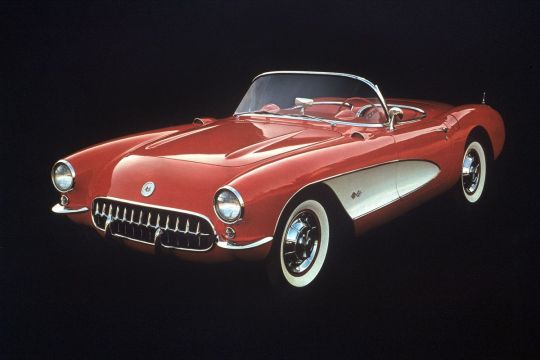
1956–1957: Birth of a LegendWe (still called Sports Cars Illustrated at the time) take an early 1956 Corvette prototype for a spin and find the stick-shift 225-hp convertible hits 60 mph in 7.5 seconds—a massive improvement over the old six-cylinder car, which took more than 11 seconds to reach the mile-a-minute mark. Things get even better in 1957, when Chevrolet enlarges the V-8's displacement to 4.6 liters (283 cubic inches) and adds an available fuel-injection system to the menu. In its most powerful state, the engine makes an eye-widening 283 horsepower.Chevrolet
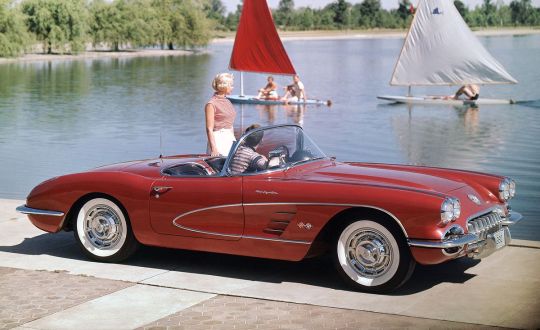
1958–1960: Four for the RoadThe Corvette goes under the knife again and emerges sporting a revised front end with a new dual-headlight design for 1958. Other changes include an updated interior that sees the tachometer move from the center of the dashboard to a location in the driver's line of sight, just below the speedometer. Power continues to rise as well, and the most potent Corvette produces a cool 290 horses from its fuel-injected V-8. That figure rises to 315 ponies for 1960.Car and Driver

1961–1962: Last GoodbyeChevrolet prepares to bid adieu to the first-generation Corvette. A redesigned rear end debuts for 1961 and introduces the sports car's now famous quad-taillight design. Chevrolet shovels its new 5.4-liter (327-cubic-inch) V-8 under the Corvette’s hood in 1962, where it makes as much as 360 horsepower in its highest-rated state.Car and Driver
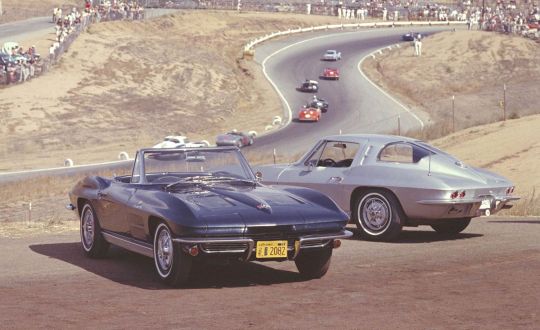
1963: Ray of LightChevrolet releases an all-new Corvette for the 1963 model year. Affectionately known as the Sting Ray, the second-generation Corvette introduces to the model an independent rear suspension and a coupe body style. The form-fitting body is once again made of fiberglass. A split-window design is unique to the first-year coupes. Chevy's 327 V-8 carries over and can be mated to either an automatic transmission or a three- or four-speed manual gearbox. In our test of the then-new Corvette, we chide Chevrolet for offering anything but the four-speed manual in the car.
Car and Driver

1963: Z-0-6Knowing the Corvette will appeal to the racing community, Chevrolet offers the model with a race-ready package dubbed Regular Production Order (RPO) Z06. The package adds a vacuum brake booster, a dual master cylinder, power drum brakes with sintered metallic brake linings, larger shock absorbers, and a bigger front anti-roll bar. Limited to Corvettes equipped with the most powerful 360-hp variant of the V-8 engine (250 horses are standard) and a four-speed manual transmission, RPO Z06 is applied to just 199 Corvettes in 1963.Chevrolet
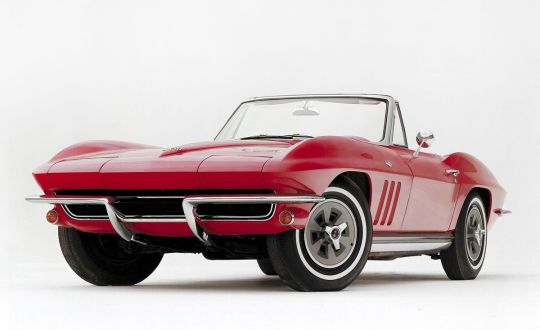
1965: Bigger Is BetterChevrolet responds to critics of the Corvette's drum brakes by equipping the car with standard four-wheel disc brakes for the 1965 model year. (Buyers can still opt for drums at a credit of $64.50.) The brake improvements are a timely upgrade, as Chevrolet also sees fit to plug its big-block V-8 engine under the Corvette's hood. The optional engine displaces 6.5 liters (396 cubic inches) and produces a monstrous 425 gross horsepower—a figure many suspect is underrated. Car and Driver

1966: (Even) Bigger is (Still) BetterFor 1966, Chevrolet increases the engine's bore, subsequently upping displacement to 7.0 liters (427 cubic inches). The bigger big-block belts out a reported 425 horsepower, with power shooting up to 435 horses for 1967. A second 427 V-8 is added to the Corvette lineup for 1967 as well. Dubbed L88, the top-of-the-line bent-eight produces 430 horses on paper. The real number, however, is closer to 560 horsepower. Just 20 buyers check the box for the beefy L88 engine.Chevrolet

1968–1971: SharknadoAfter five model years, the C2 Corvette is replaced for 1968 by the C3. The new car cribs styling details from designer Larry Shinoda's Mako Shark II concept car. The coupe no longer offers a formal rear storage area. However, the body style now includes removable roof panels. Despite the new shape, the third-generation Corvette's underpinnings are nearly identical to its predecessor's. Powertrains are largely carryover, although a new three-speed automatic transmission replaces the prior two-speed unit.
Car and Driver

1968–1971: SharknadoChevrolet reinstates the Stingray name in 1969 (now as one word) and enlarges the stroke of the standard V-8, which brings displacement up to 5.7 liters (350 cubic inches). A new V-8, also displacing 5.7 liters, finds its way under the Corvette's hood in 1970. The engine produces 370 horsepower—70 more than the base powerplant. Chevrolet also strokes the heavier big-block V-8 to 7.4 liters from 7.0 liters. That 454-cubic-inch engine makes 390 horses and is dubbed LS5. Chevrolet

1968–1971: SharknadoPower begins to fall in 1971, as octane requirements are reduced in preparation for the upcoming move to unleaded fuel. A new 425-hp big-block V-8 is introduced under the LS6 banner. We test four different powertrain variants of the sports car and find the entry-level 270-hp model with a three-speed automatic scoots to 60 mph in a reasonable enough 7.1 seconds. Meanwhile, the top-dog LS6 requires just 5.3 seconds to do the same deed.Chevrolet

1973–1976: New Bumper, Who Dis?To meet federal safety standards, the 1973 Corvette sports a new mug with a body-color urethane bumper cover. The cover adds 35 pounds to the car's weight and is able to withstand impacts of up to 5 mph without causing damage to the lights or safety features. Power continues to fall, and the entry-level 1973 Corvette spits out just 190 horsepower. Opting for the most powerful big-block engine brings just 275 horses to the stable. Chevy adds a body-color rear bumper to the Corvette in 1974. The big-block engine is pulled from the 1975 Corvette, as is the convertible body style. Catalytic converters are added, and output of the entry-level 5.7-liter V-8 falls to 165 horsepower, although a 205-hp option is available for those in search of more grunt. At this time, we put a 1975 Corvette up against a gullwinged Bricklin SV-1, finding that both front-engined vehicles lack the "essential ingredients of a modern high-performance car."
Car and Driver

1973–1976: New Bumper, Who Dis?Model year 1976 introduces a revised intake that raises power to 180 and 210 horses, respectively. The Corvette tops a Dodge Dart Sport, Pontiac Firebird Trans Am, Chevrolet C-10 Silverado, and Ford Mustang II Cobra II in a comparison test and earns its standing as the fastest American car sold in 1976. We also take a Corvette to Alaska and toward the Northwest Passage during the U.S.'s bicentennial year. The drive is grueling, and the car's chunky aftermarket tires proceed to spew mud across the Corvette's body, leaving behind "the scars of its confrontation with a world that nobody had ever designed a Stingray for."Chevrolet

1978–1982: Big BootyChevrolet celebrates the Corvette's 25th anniversary by equipping the 1978 model with a new fastback rear end. Although the large glass area placed on the rear of the Corvette does not open, it does make possible a formal rear luggage area behind the seats. Chevy enlists the 1978 Corvette to pace the Indy 500, which results in the production of 300 replica pace car Corvettes.
Car and Driver
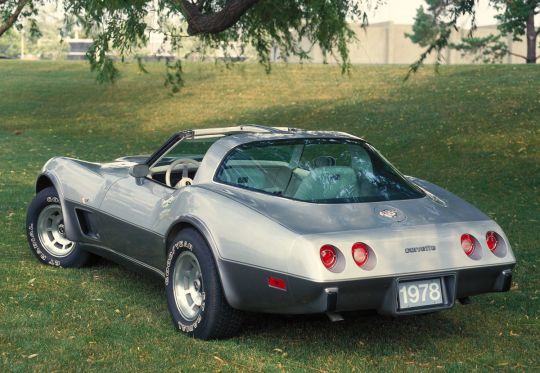
1978–1982: Big BootyThe Corvette adds 5 ponies to its stables in 1979, with the most powerful engine producing 225 horsepower. In our testing, the 3480-pound sports car accelerates to 60 mph in 6.6 seconds and through the quarter-mile in 15.3 seconds at 95 mph. Editor Rich Ceppos calls the car "the most refined ever" and advises Corvette fans to "buy now or forever hold your peace." Despite this advice, the Corvette is anything but perfect, and it falls short of the marks set by the Porsche 924 and Mazda RX-7, which beat it in a six-car comparison test. The Chevy does best an Alfa Romeo Spider Veloce, a Datsun 280ZX, and a Fiat Spider 2000.Chevrolet
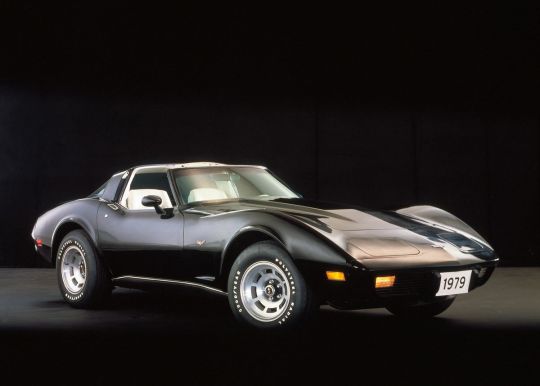
1978–1982: Big BootyBy the end of 1981, Corvette production is moved exclusively to the company's new Bowling Green, Kentucky, factory, as the old Saint Louis, Missouri, plant is formally brought offline. The sports car's age is beginning to show, though, and the Corvette finishes last in a five-car comparison test that includes a DeLorean, a Datsun 280ZX Turbo, a Porsche 911 SC, and a Ferrari 308GTSi. Chevy marks 1982 as the third-generation Corvette's final year. The model is a far cry from the car it was in 1968, and the 1982 Corvette is sold strictly with a 200-hp 5.7-liter V-8 mated to a four-speed automatic transmission.Chevrolet

1984–1985: C4 for '84Chevrolet skips model year 1983 and releases the fourth-generation Corvette as a 1984 model. The sports car is redesigned from the ground up and welcomes additional ground clearance but a lower center of gravity. A 205-hp 350-cubic-inch V-8 is the only engine offered and mates to either a four-speed automatic transmission or Chevrolet's four-plus-three manual gearbox, which offers an available overdrive for gears two, three, and four. We find the automatic car is capable of scooting the low-slung coupe to 60 mph in 6.7 seconds and through the quarter-mile in 15.1 seconds at 91 mph. In spite of our love for manual transmissions, we call the self-shifting gearbox "quite a capable tool for generating performance statistics."
Car and Driver

1984–1985: C4 for ’84Chevrolet makes a handful of tweaks to the Corvette for 1985, and we subsequently name the model to our third annual 10BestCars list, calling it an "American car that will run with the best in the world—at a fraction of their price." The sports car holds a place on our list through the rest of the decade.Chevrolet

1986: Drop the TopThe convertible returns to the Corvette lineup for 1986. In celebration, Chevrolet drafts the droptop Corvette to pace the 1986 Indianapolis 500.Car and Driver

1990: ZR-#1Chevrolet produces 84 Corvette ZR-1s in 1989, none of which are sold to the public. The ZR-1 finally reaches dealerships in 1990 and is sold through model year 1995. The model boasts a dual-overhead-cam 5.7-liter V-8 engine developed by Lotus and built by Mercury Marine. With 375 horsepower on tap and a ZF-built six-speed manual putting that power to the ground, we push a 1990 ZR-1 to 60 mph in a blistering 4.5 seconds and onto a top speed of 175 mph. To fit its massive 11-inch-wide rear wheels, the ZR-1 wears model-specific doors and rear body panels. We put the mightiest Corvette up against a Porsche 911 Turbo in 1991 and award gold to the American sports car, declaring that the "ZR-1 triumphed over the 911 Turbo for one simple reason: it goes fast better."Car and Driver

1991–1992: Redone for '91Chevrolet lightly revises the Corvette's exterior in 1991. New front and rear fascias and revised side louvers give the car a more modern appearance. A new 5.7-liter V-8 appears under the Corvette's clamshell hood in 1992. Dubbed LT1, the engine produces a comfortable 300 horsepower—50 horses more than the prior L98 engine—and 330 lb-ft of torque. Traction control is standard across the Corvette line. In July, the one-millionth Corvette rolls off the Bowling Green, Kentucky, assembly line. As an ode to the original Corvette, the millionth model is a white convertible with a red interior.Car and Driver
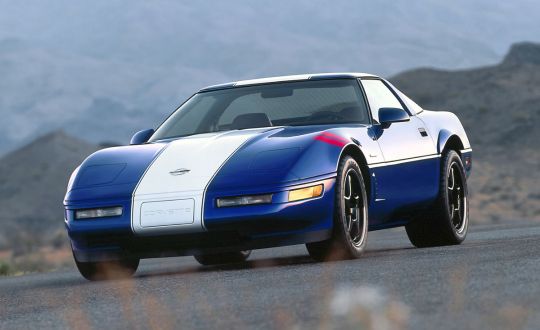
1996: A Grander CorvetteModel year 1996 sees the introduction of the one-year-only LT4 engine. The optional 5.7-liter V-8 produces 330 horsepower and mates exclusively with a six-speed manual transmission. A special Grand Sport model arrives in 1996 as well. The model harks back to the Corvette Grand Sport race cars of the 1960s. Available strictly in Admiral Blue with the more powerful LT4 engine, the Grand Sport is offered as both a coupe and a convertible. The convertible, however, does without the coupe's flared rear fenders.Car and Driver
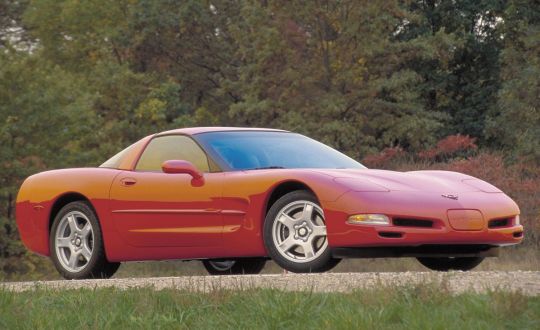
1997: I Got C5 on ItThe fifth-generation Corvette arrives in 1997. Although it evolves the style of its predecessor, the latest Corvette is a completely new animal. Power comes courtesy of Chevy's new LS1 engine. Like the LT1 and LT4 it replaces, the LS1 displaces 5.7 liters. Power now sits at 345 horses, and that output is routed through a four-speed automatic or six-speed manual transmission. Unlike past Corvettes, the fifth-generation model places its transmission at the rear of the car, up against the rear differential. Car and Driver
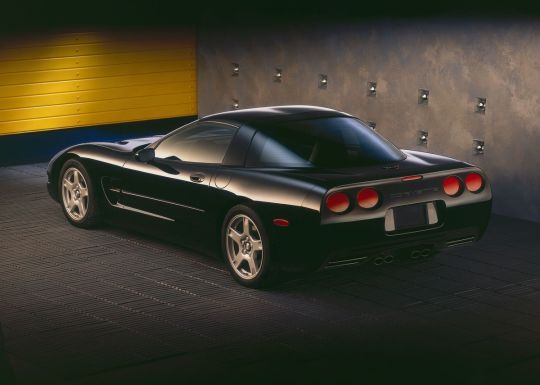
1997: I Got C5 on ItWith a nearly eight-inch-longer wheelbase and a 4.4-inch-wider front track and 2.9-inch-wider rear track, the new Corvette is both more spacious and more stable than its predecessor. It's also lighter than the old car by about 80 pounds. A convertible is introduced in 1998, and the entire Corvette model line reclaims its place on our 10Best Cars list after an absence of almost a decade.Chevrolet

1999: Couped UpChevrolet introduces the Corvette fixed-roof coupe in 1999. The body style complements the targa-topped hatchback and convertible Corvette models. The fixed-roof coupe is approximately 12 percent stiffer than its targa sibling and almost 80 pounds lighter. It's also the least expensive Corvette option and helps the car maintain its spot on our 10Best Cars list, where we declare all three forms of the model "refined, practical sports car with performance that simply can't be matched at the price."Car and Driver

2001: Zee-Oh-SixThe Corvette fixed-roof coupe begets the high-performance Corvette Z06. Introduced in 2001 with 385 horses pouring out of its V-8 engine, the Z06 cribs its name from the famed race-ready option package that Chevy first offered on the 1963 Corvette. Alongside its added power, the Z06 trims its weight relative to the standard Corvette, courtesy of thinner front and rear glass and a set of titanium mufflers. At 3126 pounds, the first Corvette Z06 we test weighs 54 pounds less than the last Corvette fixed-roof coupe to come to our office. Car and Driver

2001: Zee-Oh-SixThe Z06's improved power-to-weight ratio allows it to travel to 60 mph in a mere 4.3 seconds, or half a second quicker than any other fifth-generation Corvette we have previously tested. Chevy outdoes itself the following year and bumps the power of the Z06 to a whopping 405 horses. The addition of the Z06 puts the Corvette back on the 10Best Cars map after a two-year hiatus.Chevrolet

2005: Change (in the House of Flies)The sixth-generation Corvette is unveiled at the 2004 Detroit auto show. The model is, for the most part, an evolution of its predecessor. However, Chevy makes the revolutionary decision to ditch the Corvette's several-generations-running hidden headlights, making the 2005 Corvette the first Corvette in more than four decades to sport exposed front lamps. Although the new Vette is 5.1 inches shorter than its predecessor, the car's wheelbase measures 1.2 inches longer.
Car and Driver

2005: Change (in the House of Flies)Chevy revitalizes its LS-series engine by boring it out to 6.0 liters. Known as the LS2, the engine also sports a higher compression ratio, a raised redline, and more. The changes allow the big V-8 to push 400 horses to the rear-mounted gearbox. Transmission choices are once again limited to a four-speed automatic or six-speed manual transmission. We proceed to put the new Corvette to the test by comparing it with its bitter rival, the Porsche 911. We note that the "911 has a tick more sharpness" but ultimately hand gold to the Chevy, which costs nearly $22,000 less than the Porsche. We conclude that "For the money, there isn't a better sports car around ." Chevrolet continues to improve the Corvette over the years and replaces the antiquated four-speed automatic transmission with a new six-speed unit, while the 6.0-liter V-8 sees its displacement rise to 6.2 liters. The changes help the Corvette maintain its status on our 10Best Cars list for the remainder of the decade.Chevrolet

2006: Z06, Part Deux The Corvette Z06 re-emerges in 2006 after a brief hiatus. With the fixed-roof coupe body style killed, the new Z06 is now based on the fastback coupe and sports a lightweight aluminum frame. The model is powered by Chevrolet's latest LS-series engine, the LS7. Displacing 7.0 liters, the V-8 sports titanium connecting rods and produces a mammoth 505 horses. We soon discover all that power helps push the Z06 to 60 mph in a mere 3.4 seconds. While the Chevy bests the Dodge Viper SRT10 in a comparison test, it fails to topple the much pricier Porsche 911 Turbo and Ferrari F430.Car and Driver

2009: Return of the ZR1More than a decade after its demise, the ZR1 returns to the Corvette lineup for the 2009 model year. Unlike the prior twin-cam model, the new ZR1 makes its power courtesy of a big fat supercharger strapped to the top of Chevy's overhead-valve 6.2-liter V-8. The engine makes 638 horsepower and can propel the ZR1 to a top speed of 205 mph. We test the mightiest Corvette against the run-of-the-mill model and the 505-hp Z06 and find the six-figure ZR1 to be "one of those rare cars, such as the Ferrari F430 Scuderia and the BMW M3, that make its driver look more heroic than reality suggests."Car and Driver

2010: Granddaddy SportThe Corvette Grand Sport returns in 2010. The trim level combines the wide-body stance of the Corvette Z06 with the powertrain of the standard Corvette, and it topples a Ford Mustang Shelby GT500 in a comparison test between the two American muscle cars.Car and Driver

2013: Give or Take a Cubic InchTo celebrate the Corvette's 60th anniversary, Chevrolet plugs the Z06's 505-hp engine into the Corvette droptop. The model is called the Corvette 427 convertible, and it is capable of scooting to 60 mph in just 3.9 seconds. The name is a nod to the 427-cubic-inch V-8 offered in earlier Corvette generations as well as to the 7.0-liter V-8 under its hood that actually displaces 428 cubic inches. Don't worry, Chevy; math isn't our strong suit, either.Car and Driver
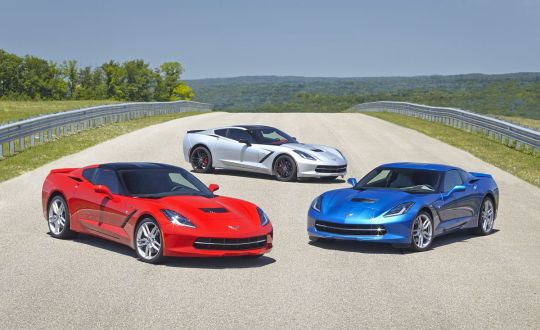
2014: Lucky Number C7Resting on a new aluminum frame, the seventh-generation Corvette arrives in 2014 and marks the model's biggest change in more than a decade. Power comes courtesy of the new LT1 V-8, which displaces 6.2 liters and pushes 455 horses (460 with an optional exhaust) to the ground by way of a six-speed automatic or seven-speed manual transmission. An eight-speed automatic replaces the six-speed unit in 2015. Every Corvette benefits from a carbon-fiber hood, and the model is once again christened Stingray. The Corvette finds its way back onto our 10Best Cars list in 2014 and 2015 but falls off the list in 2016. We test a Corvette Stingray for 40,000 miles and conclude the car is "an amazing performance bargain." Despite our infatuation with our long-term Corvette, we're left kicking dirt when the engine detonates itself at the 6000-mile mark.Car and Driver

2015: King of the HillThe Z06 reappears in 2015 and boasts a supercharged 6.2-liter V-8 engine with 650 horsepower. The mean machine is available as both a coupe and convertible and with either a seven-speed manual or an eight-speed automatic, the latter of which pulls the car to 60 mph in just 3.0 seconds. Meanwhile, a set of sticky Michelin Pilot Sport Cup 2 tires allow the mighty Corvette to stick to our 300-foot skidpad at a hair-raising 1.19 g.
Car and Driver

2017: Return to InnocenceThe wide-body Corvette Grand Sport returns for 2017 and provides the Corvette with the necessary push to find a place once again on our annual 10Best Cars list. We promptly order one for a long-term 40,000-mile test.Chris Doane Automotive - Car and Driver

2019: Big Wing BluesChevrolet reintroduces the ZR1 for 2019. The top-dog model makes 755 horsepower from its supercharged 6.2-liter V-8 engine but still manages to earn an EPA-rated 20 mpg highway fuel-economy figure when equipped with the optional eight-speed automatic transmission. A seven-speed manual is standard. We take the big-winged Corvette to the infamous Texas Mile and manage to hit 183.3 miles after traveling a mere 5280 feet.Anton Watts - Car and Driver

2020: The Corvette Finally Goes for the MiddleThe eighth-generation Corvette, dubbed C8, is the first ever from the factory to situate its engine behind the passenger compartment and ahead of the rear axle. This transition has been decades in the making, and the production car appears impressive—especially given its sub-$60,000 starting price. Chevrolet installs a 6.2-liter "LT2" V-8 in the base Stingray model, pairing it with an all-new eight-speed dual-clutch automatic transmission; no manual transmission is offered. With the Performance exhaust option, the LT2 engine produces 495 horsepower and redlines at 6600 rpm. Greg Pajo - Car and Driver

2020: The Corvette Finally Goes for the MiddleThe C8 Corvette's design is busy, to say the least, but it clearly conveys that America's sports car no longer houses its engine in its nose. Inside, Chevrolet massively stepped up the Corvette's game, with a wholly unique and quality cabin design unlike anything else in the bow-tie lineup.Greg Pajo - Car and Driver


Read the full article
3 notes
·
View notes
Photo

1968 Mercury Cougar XR-7 GT Facts⬇️⬇️⬇️⬇️⬇️⬇️⬇️⬇️ Engine: Ford FE-series (currently FT-series) OHV V-8, cast-iron block and cylinder heads Displacement: 390 cubic inches Compression ratio: 10.5:1 (currently 9.5:1, estimated) Horsepower @ RPM: 325 @ 4,800 (currently 335 hp, estimated) Torque @ RPM: 427-lb.ft. @ 3,200 Valvetrain: Hydraulic valve lifters (currently Comp Cams 270 Magnum camshaft; Harland Sharp roller rockers) Fuel system: Single Holley 600-cfm four-barrel carburetor (currently Holley 3310 750-cfm four-barrel) Electrical system: 12-volt, Autolite distributor (currently with Pertronix electronic ignition conversion) Lubrication system: Full pressure Exhaust system: Dual exhaust Transmission: Ford Toploader four-speed manual (currently Tremec TKO-500 five-speed manual) Differential: Ford 9-inch Ratio: 3.73:1 Steering: Recirculating ball, power assist Ratio: 21.6:1 Turns, lock-to-lock: 3.5 Turning circle: 40 feet Brakes: Hydraulic, front disc, rear drum, power assist Front: 11.3-inch ventilated disc Rear: 10-inch expanding drum Construction: Unitized steel body Body style: Two-door hardtop Layout: Front engine, rear-wheel drive Suspension: Front: Independent; upper wishbones, single lower control arms with articulated drag struts, coil springs, telescopic shock absorbers, anti-roll bar Rear: Live axle; semi-elliptic leaf springs, telescopic shock absorbers Wheels: Mercury styled steel Front: 14 x 6 inches Rear: 14 x 6 inches Tires: Goodyear bias-ply (currently Firestone Firehawk steel radial) Front: F70-14 (currently 235/70R14) Rear: F70-14 (currently 235/70R14) 🐆🐆🐆🐆🐆🐆🐆🐆🐆🐆🐆 #cougar #mercury #ford #gt #xr #mustang #mopar #hotrod #musclecar #v8 #chevy #car #classic #race
480 notes
·
View notes
Text
Motor For 2008 Chevy Malibu
The L72 was the most effective motor in the world at the time. It made use of rectangle-shaped ports as well as huge exhaust manifolds. The pistons were made of forged steel as well as light weight aluminum, and the pistons were ported. In 1966, the Motor For 2008 Chevy Malibu was only found in the Corvette. In 1967, the Impala got the L36 motor and also a 385 horse power version of the 427. The Turbojet, which was only available in 1968-69, was the most effective Chevy automobile ever before made.
The LS7 was one of the most effective motor on the market. The L72 was an aluminum block with 4.4-inch bore spacing. It had a capacity of four hundred and also fifty horsepower. It was additionally fitted with a port injector. The cylinder head ports were calibrated, and the ignition was managed by a lever as opposed to a crankshaft. Furthermore, the Motor For 2008 Chevy Malibu additionally featured a newer camshaft, as well as a brand-new camshaft. The LS3 was the most efficient residential cars and truck motor ever before manufactured.
The L72 was one of the most powerful motor at the time. It utilized hollow pushrods and also big exhaust manifolds to route air to the shutoffs. The Motor For 2008 Chevy Malibu also had an oxygen sensing unit. When the O2 is not functioning correctly, the fuel will certainly melt faster as well as the gas mileage will certainly lower. A malfunctioning O2 can additionally damage the ignition system as well as catalytic converter. It likewise influences the gas economic climate of an auto, chevymotorforsale.com/motor-for-2008-chevy-malibu/
The Chevy LNF Ecotec was a small-block V-8 motor. It was introduced in 1955 and also used in over half of the brand-new vehicles marketed that year. The LT1 was developed to return the V8 to its dealing with kind. It replaced the L98 and made the L98 obsolete. The LT1 made use of a cast-iron block, dual expenses camshafts, and a reverse-cooling system to maintain the combustion chambers running at a greater temperature.
If you are trying to find a substitute motor for your Chevrolet lorry, you have a range of options. Pick a dog crate motor with top quality parts that are compatible with your car's certain make and also model. Likewise, seek one that is ranked for optimum horse power. It may be essential to exchange out various other components as well, such as the intake manifold, camshaft, as well as rotating assembly. However, this is not a complicated process, and also most producers will collaborate with you to ensure that your vehicle gets the exact replacement Motor For 2008 Chevy Malibu.
If you want a naturally aspirated cage motor, you ought to try to find the ZZ632/1000 motor. This is the biggest crate motor in Chevy history. This motor has a 9-inch bore and also a 4.3-liter variation. If you require a higher equine power, you can opt for a greater compression proportion or supercharging. These two options are both cost effective and give your car a boost.
There are a selection of crate motors for Chevrolet automobiles available on the marketplace. The LSX454R is the cage motor that provides your automobile even more power. It is a Motor For 2008 Chevy Malibu V8 with a displacement of 454 cubic inches. It is also developed for high-rev drag racing as well as provides over 700 horse power. The LSX454R is much more street-friendly as well as makes around 627 hp, chevymotorforsale.com/motor-for-2008-chevy-malibu/
There are numerous kinds of Motor For 2008 Chevy Malibu. The initial was the little block V8 motor with displacement of 262 to 400 cubic inches. As the vehicles became larger, the huge block needed a bigger motor to maintain. In 1958, the big-block was presented and its capability raised to 494 as well as 500 cubic inches. In 1998, the 572 cubic-inch Chevy crate motor was released. It is still the second-highest ability Chevy crate motor, but the 632-cubic-inch variation took all the magnificence and also is set to change the old one.
0 notes
Text
1990 Chevy 1500 Motor
The 1990 Chevy 1500 Motor was presented in 2005, as well as was among the first small block V8s created by GM. It had a greater displacement than its predecessors and 4.4-inch bore spacing. The LS7 supplied 505 horsepower. The LS3 was an updated variation of the LS2, and it utilized a customized shutoff train, increased flow in the intake manifold, and a lock-nut-retained pivot round. This revamped motor is a powerful selection and a preferred alternative for most Chevrolet designs.
The 1990 Chevy 1500 Motor was one of the most powerful motor worldwide at the time. It used rectangle-shaped ports as well as big exhaust manifolds. The pistons were constructed from forged steel and aluminum, as well as the pistons were ported. In 1966, the L72 was only found in the Corvette. In 1967, the Impala got the L36 motor as well as a 385 horse power variation of the 427. The Turbojet, which was just available in 1968-69, was one of the most effective Chevy auto ever before made.
The 1990 Chevy 1500 Motor was one of the most powerful motor on the market. The L72 was a light weight aluminum block with 4.4-inch bore spacing. It had a capability of four hundred and fifty horsepower. It was likewise fitted with a port injector. The cylinder head ports were adjusted, as well as the ignition was controlled by a lever as opposed to a crankshaft. In addition, the LS7 additionally included a more recent camshaft, and also a brand-new camshaft. The LS3 was one of the most effective domestic cars and truck motor ever before made.
The 1990 Chevy 1500 Motor was the most effective motor at the time. It used hollow pushrods and large exhaust manifolds to direct air to the valves. The L72 additionally had an oxygen sensing unit. When the O2 is not working properly, the gas will certainly burn faster and also the gas mileage will decrease. A damaged O2 can also harm the ignition system as well as catalytic converter. It additionally impacts the gas economy of an automobile.
The 1990 Chevy 1500 Motor was a small-block V-8 motor. It was introduced in 1955 and made use of in over half of the brand-new autos sold that year. The LT1 was designed to return the V8 to its dealing with type. It replaced the L98 as well as made the L98 out-of-date. The LT1 made use of a cast-iron block, twin overhead camshafts, as well as a reverse-cooling system to maintain the burning chambers operating at a greater temperature level.
If you are trying to find a substitute motor for your Chevrolet, or a used one for your vehicle you have to select chevymotorforsale.com/1990-chevy-1500-motor/ will be the best choice. Pick a cage motor with quality parts that are compatible with your automobile's certain make and version. Additionally, look for one that is rated for optimum horse power. It may be needed to switch out other elements too, such as the intake manifold, camshaft, and turning assembly. Nonetheless, this is not a complicated process, and also most suppliers will work with you to ensure that your automobile gets the specific replacement motor.
If you desire a naturally aspirated cage motor, you ought to seek the ZZ632/1000 motor. This is the largest cage motor in Chevy background. This motor has a 9-inch bore and also a 4.3-liter variation. If you need a higher equine power, you can go with a greater compression ratio or supercharging. These two options are both inexpensive as well as give your vehicle a boost.
There are a variety of pet crate motors for Chevrolet automobiles offered on the marketplace. The LSX454R is the dog crate motor that provides your vehicle even more power. It is a 7.4-liter V8 with a variation of 454 cubic inches. It is also designed for high-rev drag racing as well as delivers over 700 horsepower. The LSX454R is more street-friendly as well as makes around 627 hp.
There are a number of types of crate motors. The very first was the tiny block V8 motor with displacement of 262 to 400 cubic inches. As the vehicles ended up being bigger, the large block needed a larger motor to maintain. In 1958, the big-block was introduced as well as its capacity raised to 494 and 500 cubic inches. In 1998, the 572 cubic-inch Chevy pet crate motor was launched. It is still the second-highest capability Chevy cage motor, but the 632-cubic-inch variation took all the glory and also is readied to change the old one. To know more on used 1990 Chevy 1500 Motor visit chevymotorforsale.com/1990-chevy-1500-motor/
1 note
·
View note
Text
Top 10 Ford cars of all time
The Ford Motor Business is a renowned car manufacturer responsible for generating several of the best-enjoyed automobiles of all time. In service in 1903, Ford has actually given the globe famous lorries such as the Mustang muscular tissue vehicle and the F-100 pick-up truck. Yet Ford announced last year that it is just about removing sedans from its manufacturing lineup, choosing rather focus on building much more prominent vehicles, SUVs, and greener cars. As Ford company prepares to switch gears, we take a classic look back at the 10 most iconic cars constructed by the business over the years.
10. 1955 Ford Thunderbird
We'll begin with a real standard. The 1955 Ford Thunderbird is a favorite of auto enthusiasts around the world. Many individuals think about the original two-seat Thunderbird to be the initial truly attractive Ford vehicle. It's elegant, rounded body, as well as white wall surface tires, make a bold declaration.
Understood just as the "T-Bird," this car and truck are genuinely one for the history books. Made in between 1955 and 1957, a total amount of 53,166 two-seater Thunderbirds were manufactured by Ford. A four-seat variation came later on but never ever held the glamour of both seat T-Bird.
9. 1961 Lincoln Continental
The 1961 Lincoln Continental was so popular that execs at Ford credited the cars and trucks with conserving the Lincoln brand from being discontinued. An exchangeable that has a level hood and trunk, in addition to self-destruction rear doors, the '61 Continental influenced a generation of similar cars and trucks from the 1960s.
It was the first time considering that 1951 that a Lincoln auto came furnished with rear-hinged back doors, aka suicide doors. By 1963, the Lincoln Continental went through various adjustments developed to provide more legroom and larger trunk space; however, doubters and customers never ever rather required to it. However, the 1961 Lincoln Continental stays a timeless Ford auto.
8. 1953 Ford F-100
The modern-day Ford vehicle started with the 1953 Ford F-100, extensively taken into consideration the most significant Ford pick-up of all time. Naturally, Ford had actually previously made trucks (the F-3 was created from 1948 to 1952), but the F-Series was entirely redesigned in 1953, and the outcomes showed to be both popular and also long-lasting.
This was the first Ford vehicle to come with an automatic transmission as an alternative. It verified particularly popular with farmers and individuals that had to transport heavy lots. The 1953 Ford F-100 was likewise popular with hot-rod vehicle drivers and road racers of the moment, and also versions of this truck are still modified and used in races today. In 1956, Ford revised the truck with a wraparound windscreen and also a more contemporary chassis beneath.
7. Shelby 427 Cobra
One of the very best looking and also most powerful Ford lorries of all time, the Shelby 427 Cobra inspired nearly every efficient cars and truck that came after it. The 427-cubic-inch, 7.0-liter V-8 engine was seen by many individuals as "horrendous" when the auto came out in 1962.
While the this car was ultimately a financial failing for Ford, the investment paid off in terms of supplying the company with a trademark race auto that has endured as a classic of the track. Today, classic Shelby Cobras regularly cost high-end public auctions for over $1 million.
6. 1949 Ford Customized
One of the most identifiable automobiles of its era is the 1949 Ford Personalized. This is an automobile that is conveniently recognizable with the blog post The second world war prosperity of the late 1940s as well as early 1950s. Ford created the 1949 Customized with an "envelope" body that put whatever inside a streamlined and also stylish body. It is recognized today as an accomplishment of contemporary engineering that acted as a blueprint for the American automotive sector for years.
Regretfully, Ford stopped the Custom-made nameplate after the 1972 version year. However, the 1949 edition endures as a traditional vehicle of the post-war era and also the baby boom generation. It was the most popular family cars of the very early 1950s.
5. 1986 Ford Taurus
We're not stating that the 1986 Ford Taurus is a fine-looking automobile. This is not a lorry that would be high up on the listing of collection agencies to have. That stated, the first Ford Taurus, produced in 1986, should have a position on this listing as it is the cars and truck attributed with conserving the firm from bankruptcy in the mid-1980s. The American automobile sector was in chaos in the mid-1980s, facing expanding competitors from Japan and also on the verge of collapse.
A number of firms responded to the alarming scenario by designing and generating a collection of cost effective to get as well as affordable to generate cars. For Ford, that was the Taurus, a wind resistant, front-wheel-drive sedan that the typical family can afford. The Taurus showed to be one of the most long-lasting Ford vehicles as well, lasting with six generations and over 34 years up until it was ultimately stopped in early 2019.
4. 1964 GT40
One of the very best race vehicles ever made by Ford is the 1964 GT40. Today, this automobile is an extremely wanted collectible owing to the fact that only 135 were produced. Developed by Ford to contend against the leading Ferraris of the day, the GT40 won 4 straight 24 hr of Le Mans contests between 1966 and also 1969.
The modern Ford GT autos that followed were a tribute to the GT40, with "GT" meaning "Grand Touring." Historians as well as sector analysts concur that the 1964 GT40 is just one of the best Ford race cars ever built. It's efficiency and amazing aspect are off the chart.
3. Ford F-150 SVT Raptor
When it comes to vehicles, the F-150 SVT Raptor stands atop the stack. Sturdy, tough, and resilient, the Raptor is widely taken into consideration the most effective pick-up ever before created by Ford. It's additionally Ford's most successful vehicle ever before. And while Ford is terminating almost all of its sedans, it has actually announced strategies to build a brand-new generation SVT Raptor with an aluminum body.
Followers are hoping that Ford does something unique with the engine of the brand-new SVT Raptor after previous versions thrilled with a 6.2-liter V-8 and a twin-turbo V-6. While the regular F-150 lineup is constantly a popular option amongst customers, the extra-strong (even flashy) Raptor version is a huge hit with drivers that desire their truck to be something extra special.
2. 1965 Ford Mustang
The Ford Mustang is (nearly) one of the most legendary and also preferred Ford automobile. It's likewise among the few cars and trucks (instead of trucks or SUVs) that Ford plans to continue manufacturing as a result of its enduring appeal. This begs the question of which Mustang is the coolest of perpetuity? For our cash, it is the 1965 Ford Mustang.
This belongs to the first-generation Mustangs that were made between 1964 and 1973, and also it introduced a new course of automobile called the "horsecars and truck." The 1965 Mustang established the standard for the nameplate and also produced a cult around muscle autos-- lorries with tiny bodies and also powerful engines. Over the decades, Ford has actually worked hard to change, update, and also ideal the Mustang. However they have not surpassed their accomplishments with the initial generation 1965 design.
1. Ford Design T.
Starting point on this listing should go to the car that began it all-- the Ford Design T. It is difficult to evaluate the effect of the Version T, both on the vehicle industry and production generally. Referred to as the "Tin Lizzie," the Model T is attributed with being the initial cost-effective automobile and the one that introduced vehicles to middle-class consumers.
It's manufacturing additionally caused the innovation of the contemporary assembly line. In between 1908 as well as 1927, Ford constructed 16.5 million Model Ts, and also these barebones, four-cylinder automobiles mostly popularized vehicles around the world. Today, Version T remains on the leading 10 checklists of many offered autos of all time. It was additionally named the "most prominent auto of the 20th century" in a 1999 Auto of the Century competition. Without the Model T, other cars on this listing may not exist.
This article written by Jijiautos.
1 note
·
View note
Photo
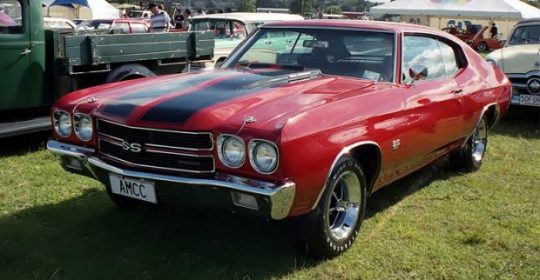
New Post has been published on https://fastmusclecar.com/top-tips-for-muscle-car-owners/best-muscle-cars/
Top Tips for Muscle Car Owners

Muscle cars have an undeniable appeal, from the absolute classic icons such as the 1964 Pontiac GTO and the 1970 Chevrolet Chevelle SS 454 to the lesser-known models and often underappreciated Studebaker Avanti R2. They are stylish, retro, and a lot of fun to drive.
There are many practical advantages of owning a muscle car in comparison with other types of vehicle—the simplicity of their engineering makes them easy to tinker with, replacement parts are cheap and accessible, and the communities of muscle car enthusiasts are welcoming and vibrant!
However, any type of vehicle has some potential drawbacks. Here are some top tips for muscle car owners to help avoid the possible pitfalls and make the most of the advantages.
Take Advantage of the Aftermarket
Compared to modern vehicles, vintage muscle cars have low gas mileage, lack luxuries such as heated seats and climate controls, and safety technologies are often pretty much limited to just a seatbelt.
Thankfully, you can overcome many of these issues by taking advantage of the huge aftermarket (both online and in physical stores) for parts, usually at low prices. Why not have the best of both worlds by installing more comfortable seats, air conditioning units, and other modern benefits in your vintage ride? If you plan on selling your car in the future, be cautious about making these changes, though, as it could lower the value.
Get Insured
This tip is essential for all vehicle owners but can be especially important for muscle car owners due to their cars’ age and the aforementioned lack of safety features. Car accidents can be extremely expensive, so insurance is a must-have. There are many companies offering vehicle insurance plans at competitive rates, such as KBDinsurance.com. Don’t go out on the road until you are covered!
Use Your Car as a Project
Modern cars have much smaller engines but more power than muscle cars, with some cars having a 213 cubic-inch V-6 engine developing 500 horsepower and 406 pound-feet of torque. In comparison, the 1967 Shelby Cobra develops 425 horsepower with a V-8 427 cubic-inch engine. Therefore, it can be a great project for you to undertake to see how much engines have changed over the years and whether you can replace your engine with something more powerful if you wish.
The good news is that the simplicity of the ignition systems and valve trains of old V8 engines makes them easy to tinker with.
If you want to learn about how cars work or even try out your first auto engineering project, you can’t go wrong with an old muscle car. It is important to note that not all muscle cars are equal when it comes to power or fuel efficiency, so a less popular model might be more difficult to source parts for.
Meet Other Muscle Car Fans
A large part of the appeal of owning a muscle car is owning a piece of history. Aside from the driving experience (which is exhilarating), the knowledge that you are preserving an important and iconic part of American culture makes any drawbacks more than worth it.
Why not show off your muscle car project to others who will appreciate it? Going to track meets and muscle car conventions will not only give you a chance to show off your pride and joy, but you can also learn some useful maintenance tips from more experienced muscle car veterans. You never know—you may even make friends for life. The muscle car community is a lot of fun to be a part of.
0 notes
Text
Original 1965 Ford Shelby GT350R for sale
The modern Ford Mustang Shelby GT350R may have just been sent to the glue factory, but an example of the car that inspired it will cross the block at Mecum’s upcoming Indianapolis auction, scheduled for May 14-21.
This 1965 Ford Shelby GT350R—serial number 5R213—is one of only 34 production cars (and two prototypes) built, as part of Ford’s earliest attempt to prove its Pony Car had real muscle. Already partnering with Shelby on the Cobra and GT40, Ford commissioned a sporty version of the Mustang, which had just launched to great fanfare in the spring of 1964.
As with the most recent version, Shelby developed both a standard GT350 and GT350R racing version. The latter is officially known as the GT350 Competition, though its traditionally referred to as a GT350R because of the “R” included in the model’s chassis code. The car won three consecutive SCCA B Production championships. Differences between the standard GT350 and the GT350R included a fiberglass lower front valance, deleted quarter windows, vented plexiglass rear windows, American Racing Torq Thrust wheels, and some engine upgrades.
The engine itself is a 289-cubic-inch V-8, which makes 325 hp in this car, and is coupled to a Borg Warner T10 M 4-speed manual transmission. Shelby originally considered independent rear suspension, but when a prototype couldn’t beat a live-axle car in a comparison at California’s Willow Springs racetrack, the idea was nixed. A group of former Shelby American employees recently built a handful of reproductions with that independent rear-suspension system, but the production Mustang would stick with its live axle for decades.
This car toured the country with the 1965 Cobra Caravan, a cross-country promotional tour organized by Shelby. The GT350R, a 427 Cobra, a GT40, and a Cobra Daytona Coupe were hauled around in a 42-foot trailer, making stops at Shelby dealers to promote sales.
After the tour concluded, the car was shipped to Peru on June 28, 1966, as one of five cars purchased by a group looking to compete in rallies and endurance races, according to Mecum. It was repatriated to the United States after which it was passed between multiple collectors over the ensuing decades. It was recently treated to a full restoration and, while it was built to win trophies on the track, it’s now winning them on the car-show circuit. Given the value of these cars, that is now their natural habitat.
This article was originally published by Motor Authority, an editorial partner of ClassicCars.com.
The post Original 1965 Ford Shelby GT350R for sale appeared first on ClassicCars.com Journal.
from ClassicCars.com Journal https://ift.tt/32TQ6qG
via IFTTT
0 notes
Text
Savage New Canaan The Fatality Of The Muscle Mass Automobile - My First Situation
How could muscle autos, one of the most powerful budget-friendly autos the world had seen, shed their pizzazz so quickly? What created them to vanish? I'm not a private investigator, not from another location like one, yet this was one instance I had to solve.
It occurred back in the 70's, however the proof was still there. It was the case of the disappearing horsepower and this is what occurred.
In the age of the muscle mass cars and truck power was everything. It didn't matter what it was, sports car, household cars and truck, pickup; it had the most significant V-8 feasible stuffed under the hood. Cubic inches were king and also promoted power was astronomical. These automobiles might kick sand in the windshields of anything else when driving.
But after that horse power appeared to vanish overnight!
Savage New Canaan
Take my favourite muscle auto, the Ford Mustang. The manly models had V-8s, though meeker designs came with an inline 6. The greatest 6 had 200 cubic inches as well as 155 hp in 1969/70.
What did the V-8s punch out? One of the most effective 351 offered 300 hp in 1970 and also the 427 provided a substantial 390 hp in 1968. However by 1973 the most effective Mustang had a 351 V-8 with simply 156 hp. Virtually half what it had in 1970, and also just one horsepower greater than the 200 cu in six of 1970! When it comes to the Mustang II of 1974, we won't even go there.
The tale was comparable with the various other producers. What was taking place? It just really did not accumulate. Could I trust the numbers?
My investigator advisor, Agatha Christie, instructed me that when you're resolving a case you can't rely on anyone. Killers do exist. In this situation it wasn't murder though it was the fatality of the muscle vehicle, and it wasn't a lot of a straight-out lie as not informing the entire reality. And outside pressures were at play.
I had to dig deeper. I had to locate the facts. Why would horse power basically cut in half?
It turned out there were a couple of reasons. Salesmanship was one. Horse power was everything so why not measure it in a salesperson pleasant way? Gross SAE horsepower was made use of. Power was gauged at the flywheel without power-hungry accessories affixed. Only the bare fundamentals were used.
In 1972 SAE Internet dimensions were phased in. Power was still gauged at the flywheel but all the accessories were set up including the full exhaust system, emission controls, all pumps and also the generator. SAE Web can't be contrasted specifically to SAE Gross because there are just a lot of variants in gauging, however it is down around 80%. So power ratings went down. In 1973 horse power rankings went down once again as power sapping emission controls were tightened.
Gross SAE horse power had actually pressed the provided power up. So did the promoted horse power some cars and truck firms used. What's incorrect with a little rounding up of the numbers for the sales brochure? Definitely that would certainly assist sales as well.
All this horse power trotting around obtained noticed and not simply by young people.
Safety lawmakers observed, therefore did insurance provider that started billing much more for insurance. The word on the road is that in 1967 a young person under 25 with a tidy driving record would certainly have paid $700 a year for GTO protection. Ouch! Some automobile business decreased their marketed horse power scores.
Savage New Canaan
Muscle mass came to a head in 1970, and also by 1971 they were starting to obtain flabbier. Engines were being detuned as well as within one more year larger engines were being gone down.
In 1973 lots of muscular tissue cars were a darkness of their former selves. And also they were finished off by the oil dilemma of late '73. Lengthy lines at filling station and also rising rates were a real shock, therefore was a 55 mph national rate restriction. Car were reckless, costly and also unwanted, it really did not matter how much enjoyable they were.
So there you have it. I now understood what had actually taken place to all that brute power. Some exaggeration had pushed detailed horsepower up. A fairer, extra accurate determining system brought it down. Exhaust controls brought it down more, and rising insurance policy prices made ground-thumping power too costly to own. The oil dilemma ended up the muscle automobile off. This case was fixed.
0 notes
Text
New Chevy Crate Motor
The New Chevy Crate Motor was introduced in 2005, and also was one of the initial small block V8s created by GM. It had a higher displacement than its predecessors and 4.4-inch bore spacing. The LS7 delivered 505 horse power. The LS3 was an updated version of the LS2, and it used a customized shutoff train, enhanced flow in the consumption manifold, as well as a lock-nut-retained pivot round. This upgraded motor is a powerful option as well as a preferred alternative for many Chevrolet models.
The New Chevy Crate Motor was one of the most powerful motor on the planet at the time. It utilized rectangle-shaped ports as well as huge exhaust manifolds. The pistons were made of built steel and aluminum, and also the pistons were ported. In 1966, the L72 was only found in the Corvette. In 1967, the Impala obtained the L36 motor and a 385 horsepower version of the 427. The Turbojet, which was only available in 1968-69, was one of the most powerful Chevy automobile ever before made.
The LS7 was the most effective motor on the marketplace. The New Chevy Crate Motor was an aluminum block with 4.4-inch birthed spacing. It had an ability of four hundred and also fifty horsepower. It was also fitted with a port injector. The cyndrical tube head ports were calibrated, and the ignition was managed by a lever as opposed to a crankshaft. Additionally, the LS7 also featured a newer camshaft, and a new camshaft. The LS3 was one of the most effective residential car motor ever manufactured.
The L72 was one of the most effective motor at the time. It used hollow pushrods as well as large exhaust manifolds to guide air to the shutoffs. The L72 likewise had an oxygen sensor. When the O2 is not working properly, the fuel will certainly burn faster and also the gas mileage will certainly decrease. A faulty O2 can also harm the spark plugs as well as catalytic converter. It also influences the gas economy of a vehicle.
The Chevy LNF Ecotec was a small-block V-8 motor. New Chevy Crate Motor was introduced in 1955 as well as used in over half of the brand-new cars sold that year. The LT1 was designed to return the V8 to its fighting type. It replaced the L98 and made the L98 out-of-date. The LT1 made use of a cast-iron block, dual overhead camshafts, as well as a reverse-cooling system to keep the combustion chambers operating at a higher temperature.
If you are seeking a replacement motor for your Chevrolet automobile, you have a selection of choices. Pick a cage motor with top quality components that are compatible with your automobile's specific make and also version. Also, search for one that is ranked for optimum horse power. It may be required to swap out various other parts also, such as the consumption manifold, camshaft, as well as rotating setting up. Nonetheless, this is not a complicated process, and also the majority of producers will certainly work with you to make sure that your car gets the precise substitute motor. chevymotorforsale.com/new-chevy-crate-motor/
If you want a naturally aspirated pet crate motor, you must search for the ZZ632/1000 motor. This is the biggest dog crate motor in Chevy history. This motor has a 9-inch birthed and a 4.3-liter displacement. If you require a higher equine power, you can choose a greater compression ratio or supercharging. These 2 options are both budget-friendly and also provide your cars and truck an increase.
There are a range of crate motors for Chevrolet lorries readily available on the market. The LSX454R is the pet crate motor that offers your car even more power. It is a 7.4-liter V8 with a displacement of 454 cubic inches. It is additionally designed for high-rev drag racing as well as provides over 700 horsepower. The New Chevy Crate Motor is more street-friendly and makes around 627 hp.
There are a number of types of pet crate motors. The very first was the little block V8 motor with variation of 262 to 400 cubic inches. As the vehicles ended up being larger, the huge block required a bigger motor to keep up. In 1958, the big-block was introduced and also its capacity increased to 494 as well as 500 cubic inches. In 1998, the 572 cubic-inch Chevy pet crate motor was released. It is still the second-highest ability Chevy pet crate motor, however the 632-cubic-inch variation took all the splendor as well as is set to replace the old one. visit chevymotorforsale.com/new-chevy-crate-motor/
0 notes
Text
SHELBY American is set to complete what its creator, Carroll Shelby referred to as ‘unfinished business.’
It is putting its fabled 1967 Ford Shelby GT500 Super Snake muscle car back into production.
But don’t get too excited. Only 10 of the mind-blowing fastbacks will be built, each with a plaque bearing the original signatures by Carroll Shelby and former employee Don McCain, who suggested a limited production run of the car back in 1967.
It all started when Goodyear wanted a special car for high speed tyre testing, and Shelby came up with the Super Snake for the engineering study.
The Super Snake’s big-block 427 cubic-inch V8 came from the Ford GT40 Mk II race car which raised output to 520 horsepower (388kW), and Shelby added heavy-duty front disc brakes, a Detroit Locker rear end, rear traction bars, a redesigned grille for improved air cooling, plus, of course, the special Goodyear Thunderbolt tyres.
It also sported triple stripes to make it stand out from other Cobras.
Carroll Shelby himself drove the car at Goodyear’s San Angelo, Texas, test track, and was clocked at 170mph (272km/h).
After an 800km test, the car set a new top speed world record for its class.
Shelby American then offered the car to Mel Burns Ford to sell and some enthusiast snapped it up for $1.7 million in Oz money.
That’s when Don McCain approached Shelby about doing a limited run of cars, but the Super Snake was a pricey bit of machinery, which discouraged McCain.
Now, 51 years later, the company will complete Carroll Shelby’s “unfinished business.”
The Continuation series Shelby GT500 Super Snakes will be built from donor 1967 Mustangs, with factory VINs and original titles.
They will be stripped to bare metal for transformation to Super Snake specifications and each comes with a Shelby serial number for the official registry.
The big block V-8 remains the heart of the Continuation Shelby Super Snake, but tuned to develop ‘more than 550hp’ and both aluminum and cast-iron blocks are available, backed by a 4-speed manual transmission and like the original, the cars will have disc brakes.
Before he died a few years ago, McCain signed 10 dash plaques for the cars, as did Carroll Shelby, indicating they knew, or hoped, that a few more of their venomous creations would emerge.
If your lotto numbers have come up and you want one of these rare snakes, you’ll be happy to know the cost is a lot less than the $1.7m the other guy paid.
One of the Shelby Cobra GT 500 Super Snakes can be yours for only $333,000.
CHECKOUT: Mind-blowing twin turbo Mustang
CHECKOUT: Watches made from scrapped Mustangs
Fabled Super snake lives again #cars #cars4start #Ford #Mustang SHELBY American is set to complete what its creator, Carroll Shelby referred to as ‘unfinished business.’ …
1 note
·
View note
Link
Brand new 1/25 scale plastic model kit of 1969 Chevrolet Camaro Yenko (Skill 2) 1/25 plastic model kit by AMT. Brand new box. Chrome plated parts. Detailed bucket seats. Vintage style packaging. SS hood and Yenko hood. 427 cubic inch V-8 engine. Black vinyl tires and metal axles. Authentic
0 notes
Text
This 1969 Chevy Camaro ZL-1 sold for north of $1 million
The 1969 ZL-1 Camaro is among the foremost desirable Chevrolet performance cars ever built.It combines the one-year-only sheetmetal of the 1969 Camaro with the rare, all-aluminum, 427-cubic-inch ZL-1 big-block that was designed with racing in mind with car dealerships in kernersville nc .Only 69 ZL-1 Camaros were built, so when one goes up purchasable , it’s an occasion . When a ‘69 ZL-1 sold for $1,094,500, as did this Hugger Orange beauty that just changed hands at Barrett-Jackson’s Scottsdale sale, it’s worth taking a better look.With a rectangular-port, open-chamber aluminum heads, and a forged crank, connecting rods, and pistons, the 427-cubic-inch ZL-1 big-block V-8 features a lot in common with the potent L88 427,but it used a solid-lifter camshaft that had slightly more lift and a touch less duration on the intake that the cam found on the L88. Both were laughably underrated at 430 horsepower. the most difference was the cylinder block , and that’s a story all its own.
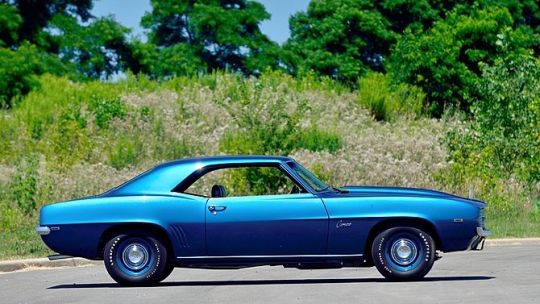
Vince Piggins was the person at Chevrolet responsible of racing performance at a time when Chevrolet wasn’t alleged to be involved in racing in the least .In an effort to alleviate government scrutiny over high-performance production cars, GM had pulled the plug on factory-backed racing in early 1963, leaving Pontiac Super Duty 421s and CorvetteGrand Sports within the lurch in chevy dealership greensboro. instead of hand over completely, Piggins headed up a team that might still support high-performance Chevrolet racing engines through other means. Piggins helped develop an aluminum 327 small-block and, eventually, a 427 big-block casting to be used in Can-Am, where it had been employed .
While the load advantage of an aluminum block was an enormous help in Can-Am, taking about 100 pounds off the nose is additionally a serious improvement during a drag car, and Piggins allowed dealers to order the powerhouse big-block in Camaros via headquarters order . Drag racers noticed. ZL-1 Camaros had a field day within the NHRA’s Super Stock class with the likes of Bill “Grumpy” Jenkins, and thus the legend of the COPO Camaro ZL-1 was born. Being rare, powerful, and delightful helped this same car sell for $770,000 in 2018 at Barrett-Jackson’s Scottsdale sale. So why the large jump in price just two years later chevy dealership greensboro nc and Hagerty marketplace expert Colin Comer told us that this car had sold once more since that 2018 sale, which the present owner made an addition that significantly impacted the car’s value—he located the car’s original, numbers-matching cylinder block and put it back where it belonged. “The location of this block had been known for a few time,” Comer explained. “Rumor states it had been replaced under warranty when the car was nearly new and had been owned by a former GM warranty administrator since that point . It supposedly had powered a ski boat and had also held other less glamorous positions since 1971 approximately

Comer was at the auction to bid on behalf of a lover who was curious about buying the Camaro. “I stood next to a different friend who declared I’d need to fight him for the car because he was getting to pay more. But neither one among us could even get a bid in! The bids quickly exceeded $800,000 between an online bidder and somebody within the room. the web bidder won out, and therefore the result's a replacement record price for a ZL-1 at auction.” The now-former record sale was back in 2005, when ZL-1 #18 changed hands for $840,000; but that very same car did not sell at $600,000 in 2016. Many seasoned honda dealership winston salem nc thought #59 would sell for much less, but its condition and specifications added up to form it one among the simplest available. “When a car has the proper options—in this case color, chambered exhaust, and four-speed—and is in exceptional condition with known provenance and factory documentation, a record result may result ,” Comer added. We’ll need to wait and see what this suggests for the remainder of the ZL-1 market and whether it'll persuade more owners to supply them purchasable in an effort to take advantage . Until then, this 1969 ZL-1 remains the sole Camaro to sell at auction for seven figures.
#honda dealership winston salem nc#car dealerships in kernersville nc#chevy dealership greensboro#chevy dealership greensboro nc
0 notes